
Ridden: August1999, June 2019
By David May
Directions to bicycle the Danube River Cycle Route, Austria, now part of Eurovèlo 6, from the Atlantic to the Black Sea
To bike the entire Eurovelo 6 route from the Atlantic, click here.
Organize your own cycling trip, or take a commercial bike tour
Bike Rating: Excellentt
|Best Seasons: Summer or Early Autumn
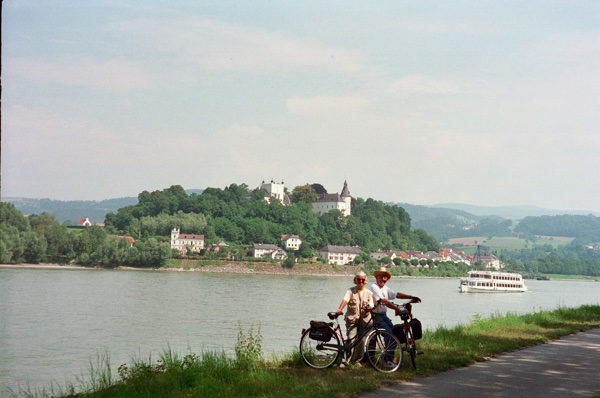
Riders beside the Danube (Donau in German) next to the bike path
Nature of the Ride: The Danube River (Donau in German) flows from its source (at Donaueschingen) in the Black Forest of Germany, to the Black Sea— 2900 kilometers (1,700 miles) downstream. Serbia and Romania are not considered safe for western bikers, on and off the road, and are not discussed here. In Germany and in Hungary, many bikers do safely follow the Danube . However, by far the most popular section for biking is in Austria, between Passau, Germany (on the Austrian border) and Vienna—a total distance of 340 kilometers (~200 miles).
This bike tour's rightful popularity arises from a great concentration of diverse views, and from tourist sights that bring new variety on each day of a ride. Additionally, except for very short sections in towns where there are sidewlks, one rides upon wide bike paths (or very minor roads) away from traffic, usually right alongside the river.
As a plus, in the case of bad weather, river steamers and trains provide a painless way to continue a journey. Finally, there are scarcely any hills and little chance of high winds. Bicycling road signs, pointing to the main routes, to variants, to nearby sights, and to hotels, usually clearly indicate the route.
Thus, the Danube bike route is excellent for families with children, and does in fact attract many families.
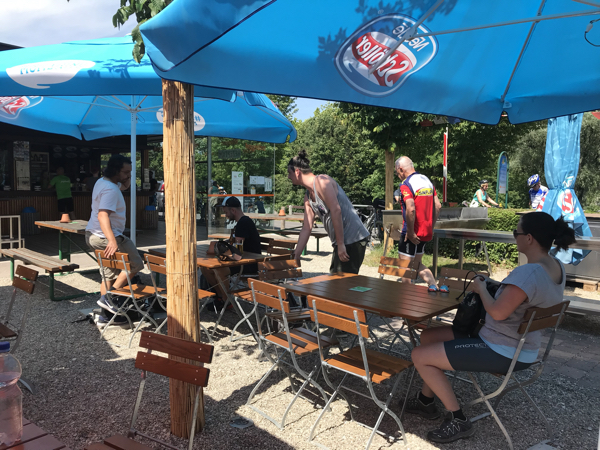
A snack bar besides the Danube bike path
The Austrian Danube Bike Route may be ridden in either direction. In favor of a trip from west to east is that you end your trip in the capital city of Vienna. You will also have the afternoon sun behind you. And if you started your trip in Germany or France west to east is the natural continuation. In favor of east to west is the fact that in Austria good weather winds generally blow from the East and normally in June through September the weather is good. (During rainy wether the wind is generally from the west.)The slope of the river is not much of a factor, as it is only at the locks – spaced 20 or more kilometers apart – that you will change elevation, by 20 t0 30 feet.
Usually there is a signed route on both sides of the river. Choose to ride on the side that has the best bike path, or the one with the shortest way, or the one with the most scenery. Bridges and ferries periodically link the two river banks. I give recommendations below in the organizing the trip yourself section.
Along the Danube route, at most stopover points, you will have a choice among many modest and superior hotels. Some require that you eat breakfast and dinner at the hotel. Many possible stops have campsite, and b&bs, but some hotel stays will be necessary. During my trips to Vienna, all hotels were welcoming, clean and comfortable.
In addition to Austrian food, there is in most towns a choice of Greek, Italian and Indian cuisine. The Indian restaraunts that I and my ipartner ate at were of very high quality.. Lunch can be found at many snack bars and small restaurants along or near the bike route. Try one jausenstation for lunchf where a local family, in the country or on a farm, serves you homemade cold cuts and cheeses on a wooden board while you sit at picnic tables.
Please refer to this site's home page for links to important background on touring styles, transportation, bike types, rentals, maps, information sources, traffic ratings, packing, and security and safety tips. Star symbols in the text show the author's ratings, which in this case are identical to the ratings given by the Michelin green guide books, which the author likes and uses. Three stars mean worth a journey; two, worth a detour; and one, interesting.
When to Go: The best weather for this itinerary is late May or early June, when it is usually less hot, but there is less chance of rain in July and August. For ny of the warm season months, you must book your hotel rooms in advance. In facr, the Austrian Danube route has become so popular that you should consifder booking six months in advance.
Tips: In the season, the bike paths can become crowded with riders, many of whom start each day from the same city. This is particularly true for those riders starting from Passau on a weekend. If convenient, start your trip mid-week. Try to be on the bike path by 9 a.m. or even earlier, because most families and groups will not leave until 9:30 or later. Another reason for an early start can be the weather: You can arrive at your next stop before the hottest part of the day and avoid possible late afternoon thunderstorms
Attractions: Your ride will take you by many castles, museums, churches, abbeys, quaint villages, beautiful towns, and some interesting cities, which are mentioned below. The Danube, itself, always pleasing and often lovely, is omnipresent. See a few photos below.
Passau**, Germany, the starting point of the ride, is a charming town at the confluence of the Inn and Danube rivers. In addition to its architecture, it has a museum with an outstanding collection of historical glass. In subsequent days, you will visit the incredible Wilhering Monestary Church***, considered the height of flamboyant baroque architecture, and the Abatial Church of Melk*** with its museum, library andgarden and pavillion, a close second. The ruined fortress above Durstein has a fine view of the town and vineyards below. The cities of Linz* and Krems-Stein**, and the town of Grein are full of charm.
Below: Passau viewed from the Inn River bridge. The Inn, though shorter, has a larger flow than the upper Danube.
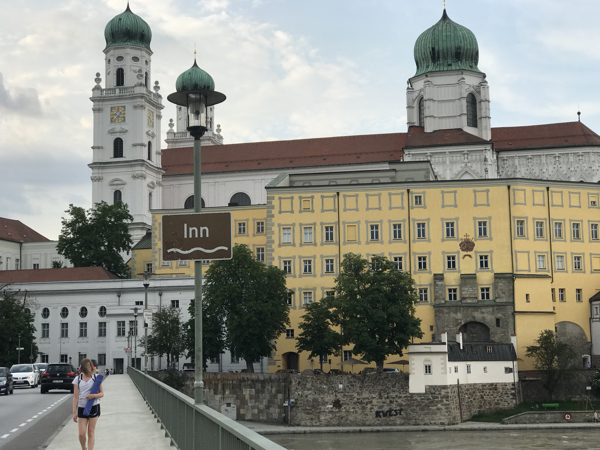
A short climb out of the valley leads to the interesting but somber Mauthausen concentration camp, or to castles of Artstetten** or Klam*. One hundredbiking kilometers before Vienna, picturesque vineyards line the river, where steep hills block the north wind.
Vienna*** ("Wien" in the German language, pronounced Veen, is a major capital with many, many attractions, some of which will appeal to any taste. Do obtain a good guidebook to the attractions, to make the best use of your time.
From Vienna, you may wish to continue by bike, boat or train to Budapest*** on the Danube (perhaps with a brief stop in Bratislava***) or tocontinue Prague***, both of which are fabulous art and architectural cities worth a multi-day visit.
The following page on Chuck Anderson's site has some excellent photos he took of the Austrian Danube while on a 1999 cross-Europe "camping" bike tour: http://www.cycletourist.com/Scenes/Austria/Donau_Sunsets.html
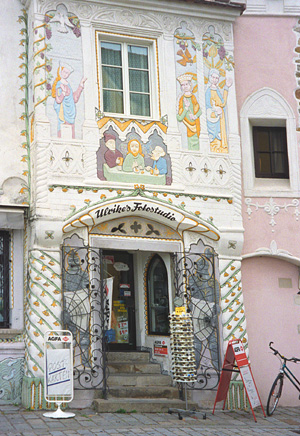
How to bike it: Organize the trip yourself, as described below; or take a commercially organized self-guided tour (with bike rentals, hotel reservations and baggage transport), or a guided tour. Two of the companies offering self-guided and guided tours are located in Austria, and may be found on the net. With very similar names they are Rad&Reise Eurocycle (radreisen.at) and Eurobike (eurobike.at). At least one USA bike touring company offers the trip. The Austrian companies have good reputations, and usually offer some flexibility in hotel choices and timing. As the cost of packing and transporting one's own bicycle can be great, if your biking is going to be limited to the Passau to Budapest trajectory, I highly recommend using bike rentals and luggage transfers, rather than bringing your own bike.
These companies typically rent bicycles at Passau and collect them at Vienna. The author's self-guiding group used the hotel-reservation, bike-rental, and luggage-transport services of Rad&Reisen Eurocycle, in Vienna, and was satisfied with an excellent trip at a very modest cost. A good discussionof the alternativesfor a Danube trip can be found a the commercial site: https://www.danube-cycle-path.com. The hotel links on this site lead to Booking.com, which may not have the best prices. I recommend that you do a search on a site such as Trip Advisor, and if you doubt your choices can store bikes, email or call the hotel to check.
Organizing the trip yourself:
Guidebook:
If you are organizing your own trip, or taking a self-guided trip, the author strongly recommends that you obtain the following bike guide book in English: "The Danube Bike Trail 2", available from Esterbauer in Austria or on the Internet shopping sites Some tour operators may supply this book as part of their package.. It contains detailed biking maps, sightseeing information, and hotel telephone numbers. (URL: www.esterbauer.com). A copy was provided by the tour company to each couple in the author's 1999 self-guiding group, at no additional cost. A German version of this book, entitled "Donau-Radweg II" is also available.)
If you are planning to bike other sections of the Danube route in Germany or Hungary (to Budapest), Esterbauer sells two other guide and map books you may wish to have, both in German: Donau-Radweg I (Germany sections of the Danube bike path), and Donau-Radweg III (Vienna-Budapest). Even if you dont read German, the detailed maps and hotel listings in these volumes will be helpful.
Distance and Time: 200 miles (340 kilometers), 7 days, plus a suggested several extra nights in Vienna.
Starting and Ending points:Usual starting point: Passau**, Germany next to Austria, but starting from Vienna is possible.. Several train routes lead through Passau. Many trains carry assembled bicycles. Ending point: Vienna*** (Wien). Many trains carry assembled bicycles. Trains return from Vienna to Passau almost every hour; the trip back by train takes 3 to 3 1/2 hours and trains continue to Munich in under 5 hours. From Vienna trains also run to Frankfurt (passing through Passau) in just under 7 hours.
Bike Rentals: Passau has several bike rental possibilities, or if you are flying to Vienna or Munich, you could rent there. Most of the rental services have provisions for returning your bicycle in Viennal. See detailed discussion of renting in Germany on my page bringing, buying, or renting your bicycle.
Lodging: If you are going to stay in hotels during the busy summer season, you absolutely should reserve them weeks in advance. If you are going to camp, the following site will help you find the campsites along the way: http://www.campsite.at/En. The individual campgrounds should be contacted in advance, to check their opening periods and availability.
To print itinerary, select the text below, right click, and choose 'print selection'.
Please follow this link for an explanation of the author's traffic ratings.
Itinerary:
Day 1: Arrive Passau** by rail. See very charming town and glass museum.

Day 2: Bike to Schlögen at the Danube pinched meander, about 44 kilometers. I stronglyrecommend the bike path on the north bank. Take a ferry to the south bank at Schlogen. The ferry to the hotel cost €2.50 in 2019, the subsequent ferries €2.00. You must cross, or take an occasional ferry that bypasses the nature reserve on the north bank.Climb on foot to the top of the ridge above hotel for a fine view. There is only one hotel, very large, with excellent meals on a veranda where one can watch the river steamers and barges.
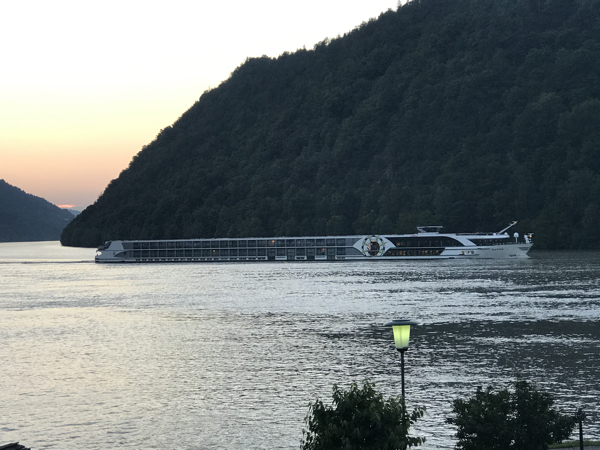
Day 3: Bike to Linz*, about 53 kilometers. Stay on the south bankuntil Wilhering. Make a one kilometer detour to visit at the Wilhering Church*** and abbey "stift". Cross by ferry to the north bank, and then in Ottensheim cros the bridge into Linz.
Wilhering Abbey Church, epitome of the Austrian Roccoco style
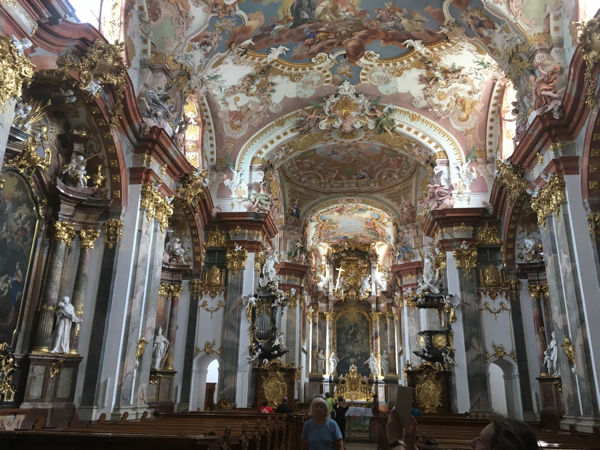
Ceiling of Wilhering Abbey churchd. It is hard to believe that this is a Cisterian abbey.
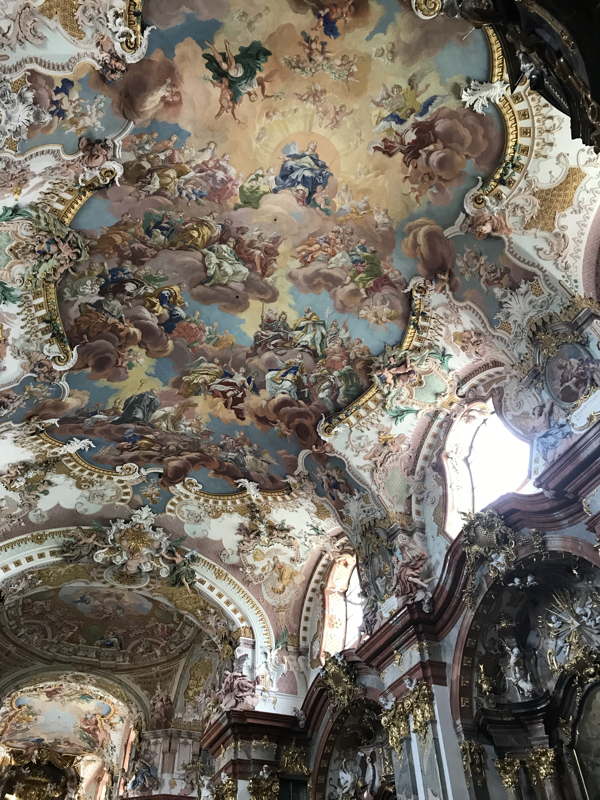
Linz street view:

Day 4: From Linz, cross the bridge and by the north bank cycle to charming Grein, about 65 kilometers. You may wish to leave the valley to visit the concentration camp at Mauthausen, and again to visit the castle and countryside at Clam*, a change of pace from the Danube valley. The Clam trip shortens the route by about 5 kilometers, but takes longer, as there is a long climb. Inside the navigation museum (Schiffahrtsmuseum) at Grein, there is a nice view over the river.
View back to Grein from the bicycle ferry to the south bank.
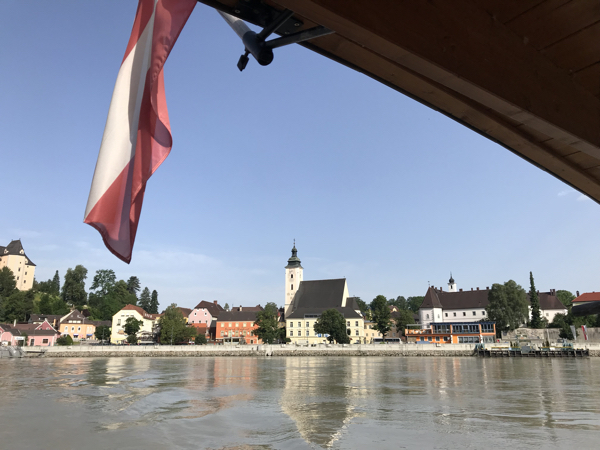
Day 5: Pedal to Melk, about 51kilometers. As the north bank path is dangerous, you must take the ferry from Grein to the south bank. Ybbs is a cute town worth a visit. Or you can cross to the north bank and pass through Persenbeg, crossing ack to the south bank just before Melk. An optional side trip, a steep climb out of the valley from Klein Pochlarn, leads to the Castle Museum of Artstetten.**. On the right bank, just before Melk, The baroque Stiftskirche (Abbey Church) of Melk*** its museum, librabury, garden and pavilion are all highly worth a visit.)
Melk abbery church:

Library (with cutouts) at Lenk abbey:
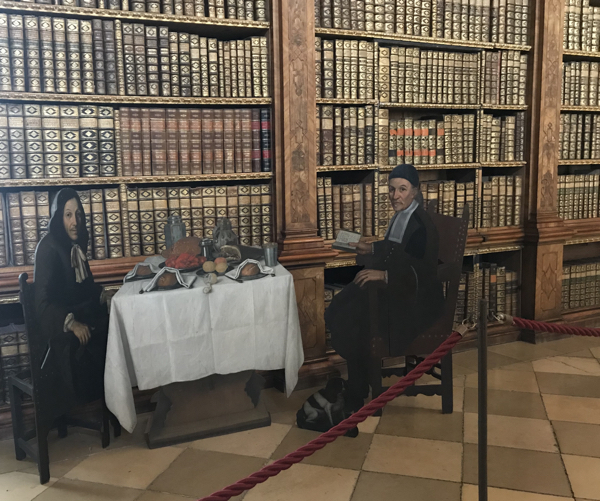
Day 6: Bike to Krems**, about 40 kilometers. From Melk cross to the north bank.On the way, pass through the hills of the Wachau** region planted in grape vines. Visit Spitz*, Durstein*, and Stein*, charming towns all (and possibly climb on foot in Spitz to the ruined castle-fort of Hinterhaus, with its spectacular views). If you are interested in newspaper cartoons, by all means visit the Karikatur Museum, in a modern building on the right after the old part of Stein.
View of Spitz and the vinyards of the Washau area:
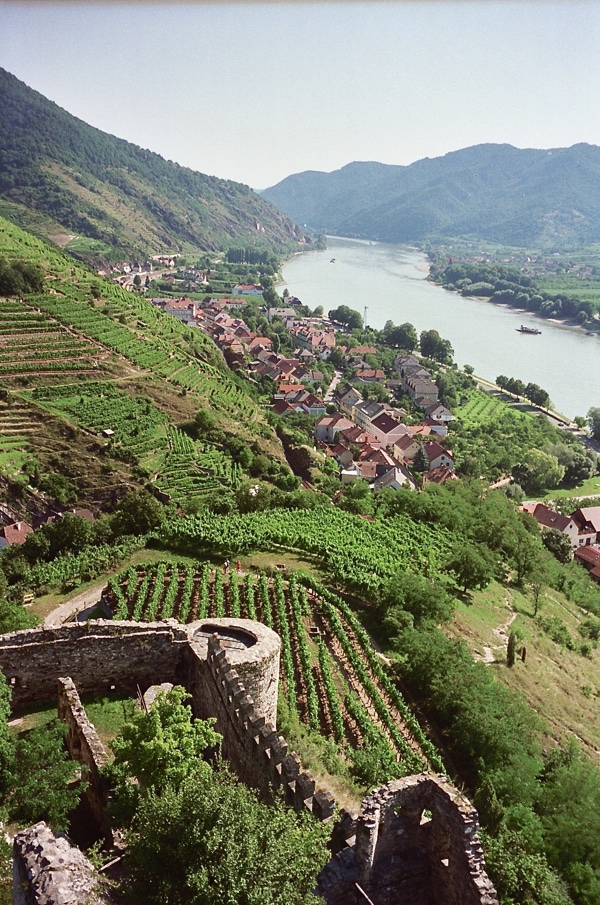
Day 7: Ride to Vienna***, about 85 kilometers. You may shorten this ride by biking to Tulln, about 45 kilometers, and taking the train into Vienna. The principal pleasure of this riding day is nature, as marshy terrain lies along the bike path; it is possible to see many birds and rabbits, as well as, perhaps, some deer. The earlier the start, the more you are likely to see. Near Vienna, you will enter residential and industrial suburbs.
The exit from Krems was the only spot in Austria in 2019 where the bicycle path was not signposted! Immediately after leaving the main spedestrian hopping street of Krems to the east, yriver. Ride southeast along the west side of this river, and eventually you will find a ramp down to the bike path visible below.
About 18 km from Krems the north bank bike path ends and after crossing via the lock bridge you continue on the south bank.
Entering Tulln, I recommend that you take the main bike path along the canal, although somewhat longer, to avoid getting lost. If you are taking the train from Tulln, I recommend getting help to find the appropriate train station, or use the map below. See the bahn.de site for the times and destinations of trains in Vienna from these stations.
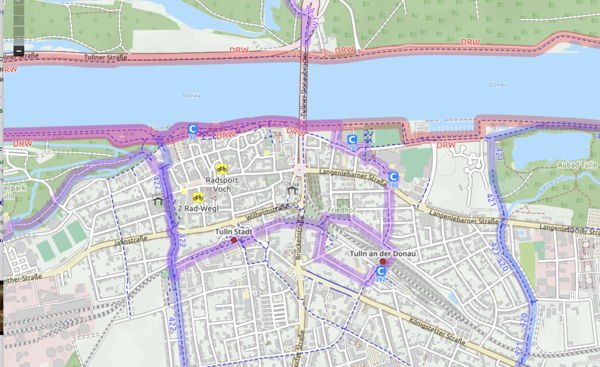
In Vienna, bicycle paths branch off in several directions , and the best route becomes unclear. Mark your destination on a good map of Vienna in advance, and, if necessary, ask for directions. To visualize the bike routes in Vienna, I recommend opencyclemap.org Type in Vienna, and enlarge the map to a highl magnification. Consult a good tourist guidebook.
Schonbrunn Castle on the outskirts of Vienna:
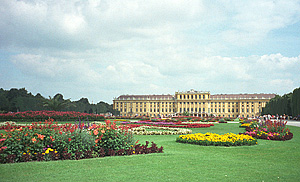 .
.